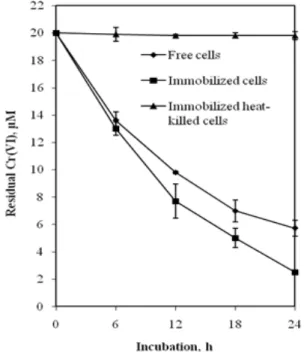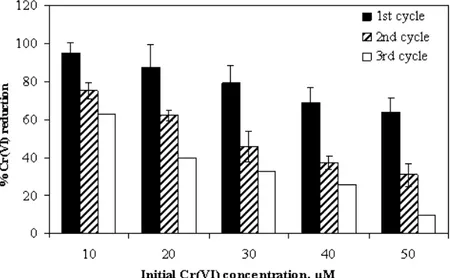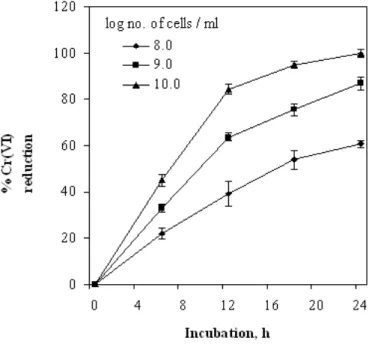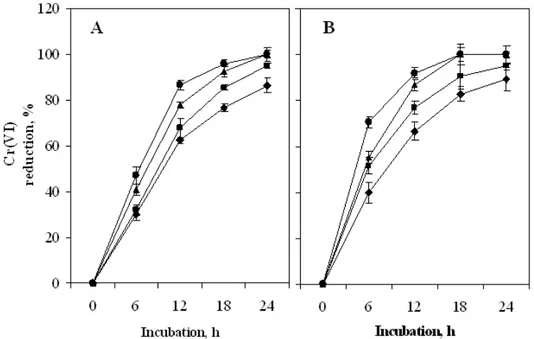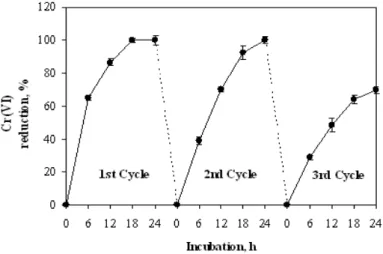Vol.56, n.3: pp. 505-512, May-June 2013
ISSN 1516-8913 Printed in Brazil BRAZILIAN ARCHIVES OF
BIOLOGY AND TECHNOLOGY
A N I N T E R N A T I O N A L J O U R N A L
Hexavalent Chromium Reduction by Immobilized Cells of
Bacillus sphaericus
AND 303
Arundhati Pal
1, Sudeshna Datta
2and Amal K. Paul
2*1Department of Botany; Serampore College, 9; William Carey Road; Serampore, Hooghly 712201 - India 2
Microbiology Laboratory; Department of Botany; University of Calcutta; 35, Ballygunge Circular Road; Kolkata 700 019 - India
ABSTRACT
Bacillus sphaericus AND 303, a Cr(VI)-resistant and reducing bacterium reported from serpentine outcrops of Andaman was evaluated for Cr(VI) reduction using immobilized cells under batch culture. Screening of inert matrices for entrapment of whole cells indicated that polyvinyl alchohol-alginate was the most effective one reducing 87.5% of 20 µM Cr(VI) in 24 h. The rate of chromate reduction was dependent on initial Cr(VI) and biomass concentrations. The PVA cell beads were recycled three times without cell leakage and disintegration. The reduction efficiency was improved in the presence of glucose and glycerol as electron donors leading to complete reduction. However, the presence of additional metal ions was inhibitory to Cr(VI) reduction. It could be emphasized that PVA-alginate immobilized cells of B. sphaericus AND 303 could be used as a continuous bioprocess in treating Cr(VI) contaminated effluents.
Key words:Bacillus sphaericus; Immobilized cells; PVA alginate; Cr(VI) reduction: Bioremediation
*Author for correspondence: amalk_paul@yahoo.co.in
INTRODUCTION
Chromium, an essential micronutrient, has widespread industrial applications in leather tanning, dye and paints, electroplating and metallurgy. The present pattern of industrial activities often discharge chromium laden waste effluents into the environment without proper treatment and leads to severe environmental pollution. Because of their non-biodegradable nature, heavy metals accumulate in the environment and in food chains and disrupt the biological processes. Although Cr can exist in different oxidation states, the hexavalent form [Cr(VI)] is highly toxic, considered mutagenic and carcinogenic as it is soluble at neutrality and easily penetrate biological membranes impairing cellular structure and functions. On the contrary, trivalent
condition or both. While aerobic chromate reduction by bacteria is associated with soluble cellular proteins utilizing endogenous electron reserves or NADH as the electron donor (Park et al. 2000; Pal et al. 2005), anaerobic reduction is membrane bound where Cr(VI) serves as the terminal electron acceptor through respiratory chains involving cytochromes (Ohtake et al. 1990; Shen and Wang 1994). Bacterial cells and enzymes immobilized in different polymer matrices such as agar-agar, agarose, polyacrylamide, calcium alginate, diatomite, polyvinyl alcohol, etc. have been used for Cr reduction and proved to be effective. These immobilized cells being more stable, can be reused and are easy to regenerate with easier solid-liquid separation (Humphries et al. 2005; Elangovan et al. 2010). Under immobilized conditions, cells are protected against the excessive toxic action of high chromate concentration and thereby improve the cellular activities compared with free cells. Cr(VI) reduction by the immobilized cells have been used in different systems such as packed bed biofilm reactor, membrane bioreactor or column bioreactors operating under batch, continuous or stirred mode (Tucker et al.1998; Pattanapipitpaisal et al. 2001; Cordoba et al. 2008).
In our previous study, we have reported a Cr(VI)-resistant and reducing bacterium, Bacillus
sphaericus AND 303 (MTCC 6512) from
serpentine outcrops of Andaman, India and have also enumerated chromate reduction studies during the growth, with viable free whole cells and using cell-free extracts (Pal and Paul 2004; Pal et al. 2005). The present study reports on the reduction of Cr(VI) by the immobilized cells of B.
sphaericus AND 303 and influence of
environmental conditions on chromate reduction.
MATERIALS AND METHODS
Bacterial strain and culture conditions
The Cr(VI)-resistant and reducing bacterial isolate
Bacillus sphaericus AND 303 (MTCC 6512) was obtained from the Microbiology Laboratory Culture Collection, Department of Botany, University of Calcutta, Kolkata and used throughout this study. The bacterium was previously isolated from serpentine outcrops of Andaman, India (Pal and Paul 2004). It was grown on slopes of Tryptic Soy Agar (Himedia, India) (containing casein hydrolysate 17.0 g; peptic
digest of soyabean 3.0 g; NaCl 5.0 g and K2HPO4 2.5 g in 1000 mL distilled water) at 32°C for 24 h and maintained with repeated sub-culturing at four weeks interval.
Preparation of biomass for immobilization
For the immobilization of cells, B. sphaericus
AND 303 was grown in 250 ml Erlenmeyer flask containing 50 ml nutrient broth at 32°C under shaking condition (120 rpm) till mid-log phase (18 h). Cells were harvested aseptically by centrifugation (10, 000 g) at 4°C for 10 min, washed thoroughly with sterile normal saline and re-suspended in the normal saline before being used for immobilization.
Preparation of immobilized cells
Polyvinyl alginate (PVA), polyvinyl borate (PVB), calcium alginate (CA), agarose (Sigma Aldrich) and agar-agar (Qualigens) were evaluated for biomass immobilization following the procedure as described by Pattanapipitpaisal et al. (2001) and Wu and Wisecarver (1992).
Polyvinyl alcohol (1.0 g) and sodium alginate (0.16 g) were mixed in 19 ml of distilled water and heated (60oC) for complete dissolution of PVA. The solution was sterilized and cooled prior to the addition of freshly prepared cell suspension (0.75 g fresh weight of biomass.). The immobilized cell beads were prepared by extruding the mixture as drops using a sterile 5 ml pipette into 200 ml of chilled CaCl2, 2H2O (2 % w/v) solution and kept overnight for hardening at 4oC. For the preparation of PVA borate beads, the extrusion was performed into an immobilizing phase containing chilled saturated boric acid and 2% (w/v) CaCl2, 2H2O. Calcium alginate beads were prepared by mixing 0.4 g sodium alginate in 19 ml distilled water, sterilized and cooled. Cells (0.75 g fresh weight) were added to the sterilized alginate solution and beads were prepared by extruding the mixture into chilled solution of CaCl2, 2H2O (200 mM) and kept overnight at 4oC for hardening. Spherical gel-beads were formed without agglomeration and exhibited rubber like properties.
on ice bath for 18 h under continuous stirring and later removed to aqueous phase.
Cr(VI) reduction studies
Cells immobilized in PVA, PVB, CA, agarose and agar-agar beads were tested for Cr(VI) reduction in batch experiments following the procedure of Humphries et al. (2005). The beads were washed three times with sterile distilled water and added aseptically to 100 ml of Erlenmeyer flask containing 10 ml of mineral salts broth supplemented with 20 µM Cr(VI) and 0.1 % glucose as electron donor. The assay was initiated by the addition of 10 beads per flasks. Beads without cells and immobilized heat killed cells were used as control. The flasks were incubated under shaking conditions (120 rpm) at 32°C and samples were withdrawn at regular interval for the determination of residual Cr(VI) following diphenyl carbazide method (Snell and Snell 1959). All the experiments were performed in triplicates and results represented the mean ± standard error.
RESULTS AND DISCUSSION
Cr(VI) reduction by free and immobilized cells
Chromate reduction by B. sphaericus AND 303 as free and PVA immobilized cells were compared under batch culture. As shown in Figure 1, in case of free cells, 14.3 µM of 20 µM Cr(VI) was
reduced (>70 %) in 24 h while immobilized cells in PVA-alginate beads showed better chromate reduction efficiency (> 85 %) under similar conditions. As expected, the immobilized heat killed cells could not reduce Cr(VI) throughout the experiment.
Five inert matrices, viz. PVA-alginate, Ca-alginate, PVA-borate, agarose and agar-agar were screened for the immobilization of B. sphaericus cells and their performance with respect to chromate reduction, bead integrity and leaching of cells from the beads were recorded. Results as shown in Table 1 revealed that PVA-alginate immoblilized cells reduced 87.5 % of 20 µM Cr(VI) after 24 h of incubation, but complete reduction of Cr(VI) could not be achieved by B. sphaericus cells in any of the matrices tested. Agar-agar, agarose and PVA-borate were inefficient for the immobilization since these beads were unstable and disintegrated within 18-24 h of incubation. Although Ca-alginate beads retained significant Cr(VI) reduction ability, cells started leaching out after 24 h and beads could not be reused. PVA-alginate beads was the most suitable one in terms of their integrity as well as efficiency of chromate reduction, hence were selected for subsequent studies. PVA-alginate was also proved to be effective immobilizing agent for Cr(VI) reduction by Streptomyces griseus (Poopal and Laxman 2008) and Microbacterium liquefaciens
(Pattanapipitpaisal et al. 2001).
Table 1 - Screening of various immobilizing matrices on Cr(VI) reduction by cells of Bacillus sphaericus AND 303.
Immobilization matrix
Cr(VI), µM Cr(VI)
reduction, % (24 h)
Bead integrity / Cell leakage Initial
(0 h)
Residual
6 h 18 h 24 h
PVA-alginate 20.0 13.6 ± 0.5 5.0 ± 0.7 2.5 ± 0.1 87.5 ± 7.2 Retained, no cell leakage Ca-alginate 19.8 13.8 ± 0.2 8.1 ±0.3 4.8 ± 0.2 75.0 ± 5.0 Retained, cell leakage after 24 h PVA-borate 20.0 14.9 ± 0.3 12.0 ± 0.2 8.1 ± 0.2 59.5 ± 3.6 Partial disintegration in 24 h Agarose 20.0 16.5 ± 1.1 15.2 ± 0.1 14.0 ± 1.2 30.0 ± 5.5 Disintegrated in 6 h
Agar-agar 19.9 18.2 ± 0.2 16.8 ± 1.5 15.6 ± 0.8 21.5 ± 2.6 Disintegrated within 24 h
Cr(VI) reduction was assayed in minimal salt medium. Results represent mean of triplicate experiments ± SE.
Effect of initial Cr(VI) concentration
Cr(VI) reduction efficiency of the immobilized cells was tested over a concentration range of 10-50 µM of Cr(VI). Reduction efficiency was higher with low levels of initial chromate but slowed down with increase in metal concentration (Fig 2). The PVA-alginate beads were effectively reused till 3rd cycle with certain degree of decline in reduction efficiency after every cycle. At low Cr(VI) concentration (10µM), fresh beads reduced more than 95% chromate in 24 h, while the reduction efficiency of the same beads declined to 62.5 % during the 3rd cycle. A visible discoloration
of the medium from yellow to colorless was accompanied with significant change in color of the recycled beads from white to grey. Such changes in color of the beads was possibly due to the precipitation of reduced Cr(III) leading to decrease in permeability of the hexavalent chromium to cells entrapped in the matrix, thereby lowering the reduction rate. This corroborated the findings of Ganguli and Tripathi (2002) who demonstrated that low levels of chromate reduction by Pseudomonas aeruginosa A2Chr was due to the inhibitory effects of high initial Cr(VI) concentration on cellular metabolism.
Figure 2 - Effect of chromate concentration on Cr(VI) reduction by Bacillus sphaericus AND 303 cells immobilized in PVA-alginate. Cr(VI) reduction was assayed after 24 h interval, cell beads were washed twice with sterile distilled water and reused for the next cycle.
Effect of cell density
Chromate reduction increased with increase in cell concentration in the PVA-alginate matrix (Fig 3). Complete reduction of initial 20 µM Cr (VI) was achieved in 24 h with a cell density of 1010
evident with the cells of B. coagulans (Philip et al. 1999) and Microbacterium sp. (Humphries et al.
2005) immobilized in polyacrylamide and PVA alginate respectively.
Figure 3 - Effect of cell concentration on chromate reduction by PVA-alginate bound cells of Bacillus sphaericus AND 303.
Effect of electron donor
The supply of a suitable electron donor, including low-molecular weight carbohydrates, amino acids, fatty acids, NADH, etc. is critical for enhancement of biological reduction of chromate (Wang and Shen 1995). Electron donors such as glucose, lactate, NADH, etc. stimulate bacterial cells by increasing the concentration of hydrogen ions, which prevents the migration and toxicity of chromate ions. Moreover, exogenous electron donors are known to increase the bioavailable hydrogen for microbial use which results in a greater extent of Cr(VI) reduction (Marsh and
McInernay, 2001). The effect of various electron donors such as glucose, glycerol, NADH, yeast extract, tryptone, glycine, acetate and propionate (0.1% w/v) on Cr(VI) reduction by PVA-immobilized cells was evaluated at a Cr(VI) concentration of 20 µM. Results illustrated in Table 2 showed that amongst the electron donors tested, glycerol was the most efficient one, followed by glucose. Moreover, the rate of Cr reduction was improved by increasing the concentrations of both glucose as well as glycerol and at 0.5% (w/v) level complete reduction was achieved in 24 and 18 h, respectively (Fig. 4).
Table 2 - Effect of electron donor on Cr(VI) reduction by PVA immobilized cells of Bacillus sphaericus AND 303.
Experiment was conducted in minimal salt medium and Cr(VI) was assayed at 24 h interval. Results represent mean of triplicate experiments ± SE.
Electron Donor (0.1%) Cr(VI), µM Cr(VI) reduction, %
Initial Final
Glucose 20 2.7 ± 0.2 86.5 ± 7.6
Glycerol 20 2.2 ± 0.1 89.0 ± 6.1
NADH 20 4.3 ± 0.1 78.5 ± 3.6
Yeast Extract 20 5.6 ± 0.6 72.0 ± 1.5
Tryptone 20 9.2 ± 0.5 54.0 ± 1.2
Glycine 20 10.8 ± 1.1 46.0 ± 1.3
Na-acetate 20 15.3 ± 0.8 22.5 ± 0.8
Figure 4 - Effect of glucose (A) and glycerol (B) concentration on Cr(VI) reduction by PVA-alginate immobilized cells of Bacillus sphaericus AND 303. Reduction experiments were conducted in minimal broth using an initial Cr(VI) concentration of 20 µM supplemented with 0.1 % (- -), 0.2 % (- -), 0.5 % (- -) and 1.0 % (-●-) (w / v) of glucose and glycerol as electron donors. Residual Cr(VI) was estimated at 6 h interval following diphenyl carbazide method.
Significant increase in the rate of Cr(VI) reduction by the addition of an exogenous electron donor such as glucose or glycerol has been observed in several Cr(VI) reducing bacteria such as
Enterobacter cloacae (Ohtake et al. 1990),
Arthrobacter rhombi (Elangovan et al. 2010), Pseudomonas aeruginosa (Ganguli et al. 2002),
Bacillus stearothermophilus (Manolov et al. 1995), etc.
Effect of other heavy metals
The influence of metal ions such as Ni(II), Cd(II), Co(II), Cu(II) (as chloride salts) and Pb(II) (as nitrate) on the reduction of Cr(VI) was studied using glucose as electron donor. The presence of each of these metals along with Cr(VI) at equimolar concentration in the reaction mixture inhibited the chromate reduction process significantly. The degree of inhibition was recorded as follows: Ni(II) > Cd(II) > Pb(II) > Co(II) > Cu(II) (Table 3). Copper was least inhibitory and immobilized cells of AND 303 reduced > 60% of 20 µM Cr(VI) in 24 h. Likewise, Hg(II) or Ag(II) strongly inhibited
Cr(VI) reduction in Escherichia coli ATCC 33456 (Bae et. al. 2000). However, reductase activity in
Enterobactor cloacae (Wang et. al. 1990) was completely blocked by Ag(II) and Hg(II). Such inhibitory effects could be attributed to the interference of these metal ions with the uptake of Cr(VI) by the bacterial cell and/or other metabolic functions, which eventually inhibited chromate reductase activity (Ohtake and Silver 1994).
Reuse of beads under optimized condition
Table 3 - Effect of other heavy metals on Cr(VI) reduction by PVA immobilized cells of Bacillus sphaericus AND 303.
Metals Cr(VI),µM Cr (VI) reduction,
% Inhibition, %
Initial Final
Control (only Cr) 20 2.35 ± 0.3 88.2 ± 6.5 0
Cu(II) + Cr(VI) 20 7.5 ± 0.1 62.5 ± 2.5 29.18
Co(II) + Cr(VI) 20 9.75 ± 0.1 51.2 ± 3.0 41.93
Pb(II) + Cr(VI) 20 11.25 ± 0.5 43.7 ± 1.5 50.42
Cd(II) + Cr(VI) 20 12.8 ± 1.2 36.0 ± 4.5 59.21
Ni(II) + Cr(VI) 20 14.15 ± 0.5 29.2 ± 2.6 66.86
Cr(VI) reduction in minimal salts broth was assayed after 24 h interval following diphenylcarbazide method. Heavy metals were added in equimolar concentration as Cr(VI). Results represent mean of triplicate experiments ± SE.
Figure 5 - Reusability of PVA-alginate immobilized cells of Bacillus sphaericus AND 303 in batch
operations. Cr(VI) reduction were conducted in shaking condition (120 rpm) for 24 h cycle at 32ºC. Beads (10 mg wet cells per bead) from each cycle were washed with sterile distilled water and transferred to fresh minimal broth supplemented with 20 µM Cr(VI) and 0.5 % glycerol as electron donor.
The gradual decrease in the reduction of Cr(VI) after 3rd cycle (Fig. 2) could be attributed to the loss of matrix stability as well as release of B. sphaericus cells and reductase in the long term shaking incubation and repeated wash as observed in Pseudomonas aeruginosa (Pang et al. 2011),
Desulfovibrio vulgaris and Microbacterium sp. (Humphries et al. 2005) The deterioration or changes of biochemical features of the strain during the process of reduction could be another possibility (Pang et al. 2011). The understanding of this phenomenon could be used to improve the stability of B. sphaericus cells in order to apply it in an efficient continuous reduction system.
CONCLUSION
B. sphaericus AND 303 was successfully
REFERENCES
Bae WC, Kang TG, Kang IK, Won YJ, Jeong BC. Reduction of hexavalent chromium by Escherichia coli ATCC 33456 in batch and continuous cultures. J. Microbiol. 2008; 38: 36-39.
Cervantes C, Campos-Garcia J, Devars S, Gutierrez-Corona F, Loza-Tavera H, Torres-Guzman JC, Moreno-Sanchez R. Interactions of chromium with microorganisms and plants. FEMS Microbiol. Rev.
2001, 25: 335-347.
Cordoba A, Vargas P, Dussan J. Chromate reduction by
Arthrobacter CR47 in biofilm packed bed reactors. J. Haz. Mat. 2008; 151: 274-279
Elangovan R, Philip L, Chandraraj K. Hexavalent chromium reduction by free and immobilized cell-free extract of Arthrobacter rhombi - RE. Appl. Biochem. Biotechnol. 2010; 160: 81-97.
Ganguli A, Tripathi AK. Bioremediation of toxic chromium from electroplating effluent by chromate-reducing Pseudomonas aeruginosa A2Chr in two bioreactors. Appl. Microbiol. Biotechnol. 2002; 58: 416-420.
Humphries AC, Nott KP, Hall LD, Macaskie LE. Reduction of Cr(VI) by immobilized cells of
Desulfovibrio vulgaris NCIMB 8303 and
Microbacterium sp. NCIMB 13776. Biotechnol. Bioeng. 2005; 90: 589-596.
Manolov RJ, Kambourova MS, Emanuilova EI. Immobilization of Bacillus stearothermophilus cells by entrapment in various matrices. Proc. Biochem.
1995, 30: 141-144.
Marsh TL, McInernay MJ. Relationship of hydrogen bioavailability to chromate reduction in aquifer sediments. Appl. Environ. Microbiol. 2001, 67: 1517-1521.
Nilsson K, Birnbaum S, Flygare S, Linse L, Schroder U, Jepfson U, Larsson PO, Mosbach IC, Brodelius P. A general method for the immobilization of cells with preserved viability. Eur. J. Appl. Microbiol. Biotechnol. 1983, 17: 319-326.
Ohtake H, Komori K, Cervantes C. Chromate-resistance in a chromate-reducing strain of
Enterobacter cloacae. FEMS Microbiol. Lett. 1990, 67: 85-88.
Ohtake H, Silver S. Bacterial detoxification of toxic chromate. In Choudhuri GR, editor. Biological degradation and bioremediation of toxic chemicals. New York: Springer, 1994; 403–415.
Pal A, Dutta S, Paul AK. Reduction of hexavalent chromium by cell-free extract of Bacillus sphaericus
AND 303 isolated from serpentine soil. Curr. Microbiol. 2005; 51: 327-330.
Pal A, Paul AK. Aerobic chromate reduction by chromium-resistant bacteria isolated from serpentine soil. Microbiol. Res. 2004; 159: 347-354.
Pang Y, Zeng GM, Tang L, Zhang Y, Liu YY, Lei XX, Wu MS, Li Z, Liu C. Cr(VI) reduction by
Pseudomonas aeruginosa immobilized in polyvinyl alchohol/sodium alginate matrix containing multi-walled carbon nanotubes. Biores. Technol. 2011, 102: 107733-10736.
Park CH, Keyhan B, Wielinga B, Fendorf S, Matin A. Purification to homogeneity and characterization of a novel Pseudomonas putida chromate reductase. Appl. Environ. Microbiol. 2000, 66: 1788-1795.
Pattanapipitpaisal P, Brown NL, Macaskie LE. Chromate reduction by Microbacterium liquefaciens
immobilised in polyvinyl alcohol. Biotechnol. Lett. 2001; 23: 61-65.
Philip L, Iyengar L, Venkobachar C. Immobilized microbial reactor for the biotransformation of hexavalent chromium. Int. J. Environ. Pollut. 1999, 11: 202–210.
Poopal AC, Laxman RS. Hexavalent chromate reduction by immobilized Streptomyces griseus. Biotechnol. Lett. 2008; 30: 1005-1010.
Shen H, Wang YT. Characterization of enzymatic reduction of hexavalent chromium by Escherichia coli ATCC 33456. Appl. Environ. Microbiol. 1993; 59: 3771-3777.
Tucker MD, Barton LL, Thomson BM. Reduction of Cr, Mo, Se and U by Desulfovibrio desulfuricans
immobilised in polyacrylamide gels. J. Ind. Microbiol. Biotechnol. 1998, 20, 13-19.
Wang PC, Mori T, Toda K, Ohtake H. Membrane associated chromate reductase activity from
Enterobacter cloacae. J. Bacteriol. 1990, 172: 1670-1672.
Wang Y. Microbial reduction of chromate. In Lovley DR. (editor) Environmental microbe-metal interactions. Washington, American Society for Microbiology Press. 2000, 225-235
Wang YT, Shen H. Bacterial reduction of hexavalent chromium. J. Ind. Microbiol. Biotechnol. 1995, 14: 159-163.
Wu KA, Wisecarver KD. Cell immobilization using PVA crosslinked with boric acid. Biotechnol. Bioeng.
1992, 39: 447–449.
